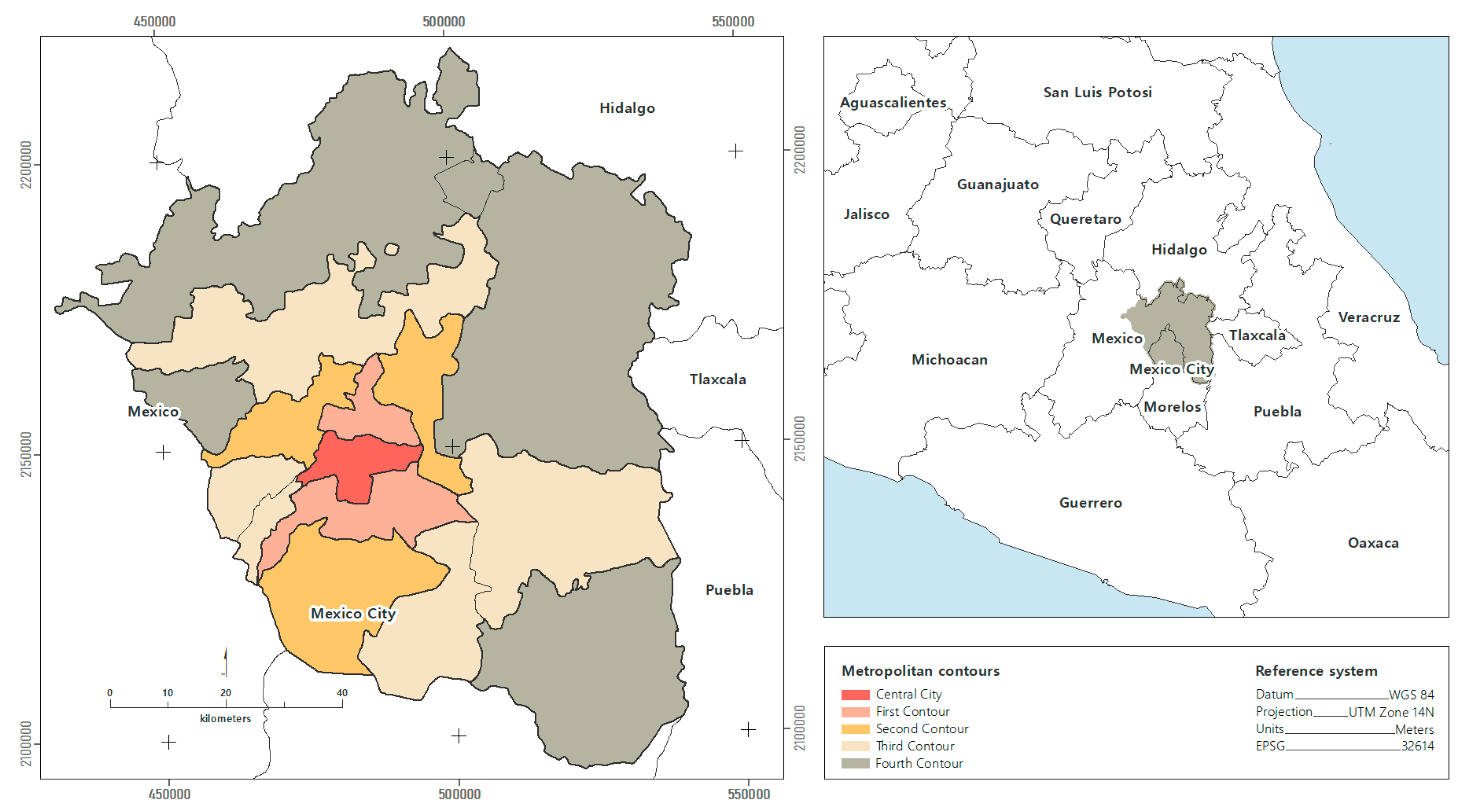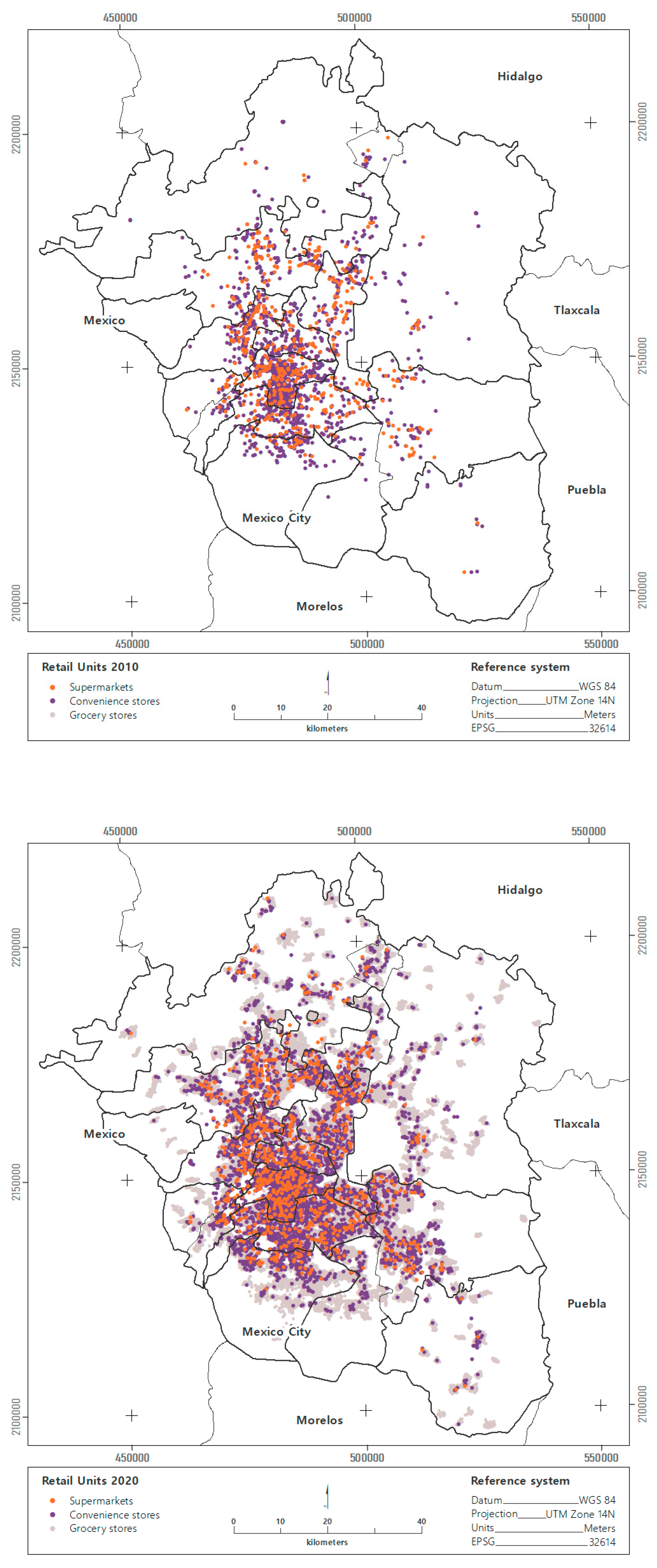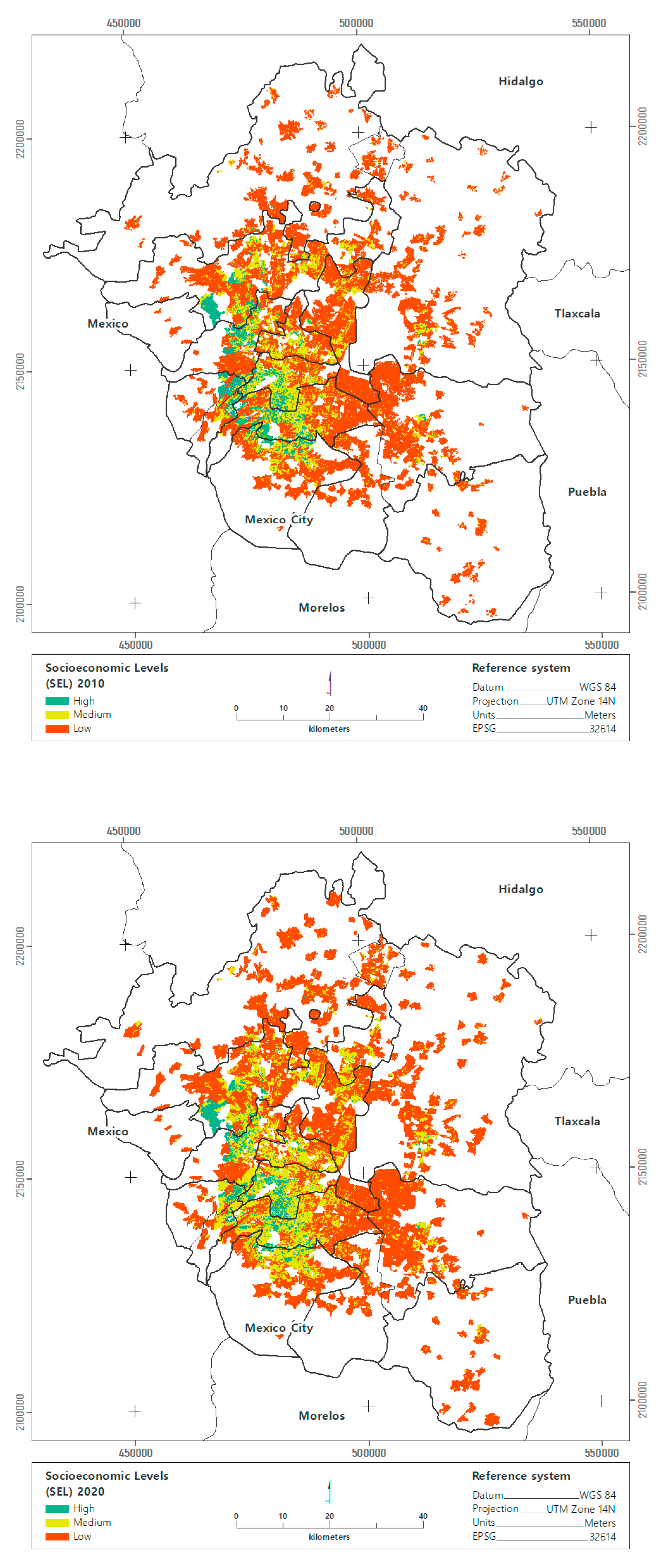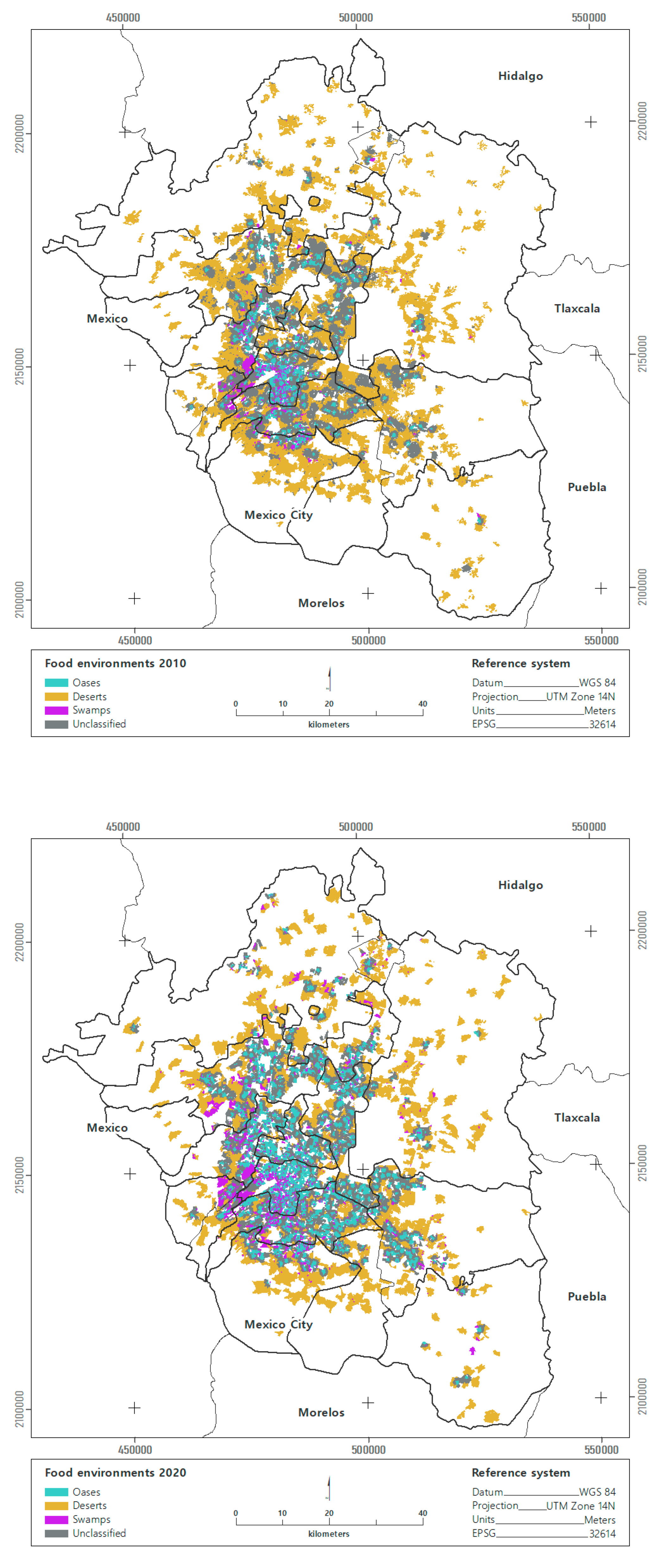Changes in Food Environment Patterns in the Metropolitan Area of the Valley of Mexico, 2010–2020
Abstract
1. Introduction
2. Materials and Methods
2.1. Study Area
2.2. Methodology
2.2.1. Physical Access to Food: Network Distance Analysis to Retail Food Units
2.2.2. Financial Access to Food: An Estimate of Socioeconomic Status at an Urban Block Scale
2.2.3. Criteria for the Definition of Urban Food Environments: Deserts, Oases, and Swamps
3. Results
3.1. Network Distance to Economic Units of Food Retail Trade
3.2. Socioeconomic Status at the Urban Block Scale
3.3. Urban Food Environments
4. Discussion
5. Conclusions
Author Contributions
Funding
Acknowledgments
Conflicts of Interest
References
- World Bank Group. Future of Food: Harnessing Digital Technologies to Improve Food System Outcomes; World Bank Group: Singapore, 2019. [Google Scholar]
- Battersby, J.; Watson, V. Urban Food Systems Governance and Poverty in African Cities; Taylor & Francis: Abingdon, UK, 2018. [Google Scholar]
- Fanzo, J.; Arabi, M.; Burlingame, B.; Haddad, L.; Kimenju, S.; Miller, G.; Nie, F.; Recine, E.; Serra-Majem, L.; Sinha, D. Nutrition and food systems. In A Report by the High Level Panel of Experts on Food Security and Nutrition of the Committee on World Food Security; FAO: Rome, Italy, 2017. [Google Scholar]
- Robitaille, É.; Paquette, M.-C. Development of a Method to Locate Deserts and Food Swamps Following the Experience of a Region in Quebec, Canada. Int. J. Environ. Res. Public Health 2020, 17, 3359. [Google Scholar] [CrossRef] [PubMed]
- Rosenkranz, R.R.; Dzewaltowski, D.A. Model of the home food environment pertaining to childhood obesity. Nutr. Rev. 2008, 66, 123–140. [Google Scholar] [CrossRef] [PubMed]
- Downs, S.M.; Ahmed, S.; Fanzo, J.; Herforth, A. Food Environment Typology: Advancing an Expanded Definition, Framework, and Methodological Approach for Improved Characterization of Wild, Cultivated, and Built Food Environments toward Sustainable Diets. Foods 2020, 9, 532. [Google Scholar] [CrossRef] [PubMed]
- Apparicio, P.; Cloutier, M.-S.; Shearmur, R. The case of Montreal’s missing food deserts: Evaluation of accessibility to food supermarkets. Int. J. Health Geogr. 2007, 6, 1–13. [Google Scholar] [CrossRef]
- Lado-Sestayo, R.; Aldrey-Pereiro, C.; Isabel Carballo-Valadares, I. Comercio Tradicional: Análisis, Evolución y Distribución Espacial; Munich Personal RePEc Archive: Munich, Germany, 2012. [Google Scholar]
- Casado Izquierdo, J.M. Supermercados en México: Expansión y espacios de inserción. Estud. Geográficos 2018, 79, 167–190. [Google Scholar] [CrossRef]
- Rose, D.; Bodor, J.N.; Swalm, C.M.; Rice, J.C.; Farley, T.A.; Hutchinson, P.L. Deserts in New Orleans? Illustrations of Urban Food Access and Implications for Policy; University of Michigan National Poverty Center/USDA Economic Research Service Research: Ann Arbor, MI, USA, 2009. [Google Scholar]
- Larsen, K.; Gilliland, J. Mapping the evolution of ‘food deserts’ in a Canadian city: Supermarket accessibility in London, Ontario, 1961–2005. Int. J. Health Geogr. 2008, 7, 16. [Google Scholar] [CrossRef]
- Walker, R.E.; Fryer, C.S.; Butler, J.; Keane, C.R.; Kriska, A.; Burke, J.G. Factors Influencing Food Buying Practices in Residents of a Low-Income Food Desert and a Low-Income Food Oasis. J. Mix. Methods Res. 2011, 5, 247–267. [Google Scholar] [CrossRef]
- Popoca-Cruz, P.E. El Modelo Gravitacional Como Medida del Acceso Alimentario: Una Propuesta Para México; Centro de Investigación en Ciencias de Información Geoespacial: Mexico City, Mexico, 2014. [Google Scholar]
- Álvarez-Lobato, J. Desiertos alimentarios en la Zona Metropolitana de Toluca. In C. Alvarado, R. Gómez y R. Hidalgo (Coords.), Expresión Territorial de la Segmentación y la Segregación; Universidad Autónoma del Estado de Morelos: Cuernavaca, Mexico, 2016; pp. 145–165. Available online: https://cutt.ly/SL95hXK (accessed on 30 May 2022).
- French, S.A.; Tangney, C.C.; Crane, M.M.; Wang, Y.; Appelhans, B.M. Nutrition quality of food purchases varies by household income: The SHoPPER study. BMC Public Health 2019, 19, 231. [Google Scholar] [CrossRef]
- Vilar-Compte, M.; Burrola-Méndez, S.; Lozano-Marrufo, A.; Ferré-Eguiluz, I.; Flores, D.; Gaitán-Rossi, P.; Teruel, G.; Pérez-Escamilla, R. Urban poverty and nutrition challenges associated with accessibility to a healthy diet: A global systematic literature review. Int. J. Equity Health 2021, 20, 40. [Google Scholar] [CrossRef]
- Ricciuto, L.; Tarasuk, V.; Yatchew, A. Socio-demographic influences on food purchasing among Canadian households. Eur. J. Clin. Nutr. 2006, 60, 778–790. [Google Scholar] [CrossRef]
- Ward, P.R.; Verity, F.; Carter, P.; Tsourtos, G.; Coveney, J.; Wong, K.C. Food stress in Adelaide: The relationship between low income and the affordability of healthy food. J. Environ. Public Health 2013, 2013, 968078. [Google Scholar] [CrossRef] [PubMed]
- World Bank Group. Poverty and Shared Prosperity 2018: Piecing Together the Poverty Puzzle; World Bank Group: Singapore, 2018. [Google Scholar]
- Huntington, E.H. Spending of Middle-Income Families. In Spending of Middle-Income Families; University of California Press: Berkeley, CA, USA, 2020. [Google Scholar]
- Booth, S.L.; Sallis, J.F.; Ritenbaugh, C.; Hill, J.O.; Birch, L.L.; Frank, L.D.; Glanz, K.; Himmelgreen, D.A.; Mudd, M.; Popkin, B.M.; et al. Environmental and Societal Factors Affect Food Choice and Physical Activity: Rationale, Influences, and Leverage Points. Nutr. Rev. 2001, 59, S21–S36. [Google Scholar] [CrossRef] [PubMed]
- Glanz, K.; Sallis, J.F.; Saelens, B.E.; Frank, L.D. Healthy nutrition environments: Concepts and measures. Am. J. Health Promot. 2005, 19, 330–333. [Google Scholar] [CrossRef] [PubMed]
- Taylor, D.E.; Ard, K.J. Research Article: Food Availability and the Food Desert Frame in Detroit: An Overview of the City’s Food System. Environ. Pract. 2015, 17, 102–133. [Google Scholar] [CrossRef]
- Walker, R.E.; Keane, C.R.; Burke, J.G. Disparities and access to healthy food in the United States: A review of food deserts literature. Health Place 2010, 16, 876–884. [Google Scholar] [CrossRef]
- Hager, E.R.; Cockerham, A.; O’Reilly, N.; Harrington, D.; Harding, J.; Hurley, K.M.; Black, M.M. Food swamps and food deserts in Baltimore City, MD, USA: Associations with dietary behaviours among urban adolescent girls. Public Health Nutr. 2017, 20, 2598–2607. [Google Scholar] [CrossRef]
- Wagner, J.; Hinton, L.; McCordic, C.; Owuor, S.; Capron, G.N.; Arellano, S.G. Do Urban Food Deserts Exist in the Global South? An Analysis of Nairobi and Mexico City. Sustainability 2019, 11, 1963. [Google Scholar] [CrossRef]
- Frayne, B.; McCordic, C. Food Swamps and Poor Dietary Diversity: Longwave Development Implications in Southern African Cities. Sustainability 2018, 10, 4425. [Google Scholar] [CrossRef]
- Battersby, J. The Food Desert as a Concept and Policy Tool in African Cities: An Opportunity and a Risk. Sustainability 2019, 11, 458. [Google Scholar] [CrossRef]
- Zhong, T.; Si, Z.; Crush, J.; Xu, Z.; Huang, X.; Scott, S.; Tang, S.; Zhang, X. The Impact of Proximity to Wet Markets and Supermarkets on Household Dietary Diversity in Nanjing City, China. Sustainability 2018, 10, 1465. [Google Scholar] [CrossRef]
- del Río Expósito, F. Caracterización del Ambiente Alimentario de Abastecimiento en Molina, Chile, 2020: Aportes Para la Construcción de Ambientes Alimentarios Saludables en Chile:“El Ambiente Alimentario de Abastecimiento en Molina, Chile”; Pontificia Universidad Catolica de Chile: Santiago, Chile, 2021. [Google Scholar]
- Borges, A.C.; Cabral-Miranda, W.; Constante Jaime, P. Urban food sources and the challenges of food availability according to the Brazilian dietary guidelines recommendations. Sustainability 2018, 10, 4643. [Google Scholar] [CrossRef]
- Denegri, F.M.; Ley, G.J. Desiertos alimentarios urbanos: La ciudad de Mexicali. In Ciudad y Sustentabilidad. Estructura Urbana; Álvarez, G.B., Ayala, M.E.G., Eds.; Universidad Autónoma de Baja California: Tijuana, México, 2020; p. 25. [Google Scholar]
- Bridle-Fitzpatrick, S. Food deserts or food swamps? A mixed-methods study of local food environments in a Mexican city. Soc. Sci. Med. 2015, 142, 202–213. [Google Scholar] [CrossRef] [PubMed]
- FAO; IFAD; UNICEF; WFP; WHO. The State of Food Security and Nutrition in the World 2021. Transforming Food Systems for Food Security, Improved Nutrition and Affordable Healthy Diets for All; FAO: Rome, Italy, 2021; p. 211. [Google Scholar]
- Marín-Domínguez, V.H. Estructura y Condiciones del Mercado Laboral en la Zona Metropolitana del Valle de México 1999–2010; Universidad Nacional Autónoma de México: México, Mexico, 2015. [Google Scholar]
- Instituto Nacional de Estadística y Geografía. Censo de Población y Vivienda 2020. 1o años 2020. Available online: https://www.inegi.org.mx/programas/ccpv/2020/ (accessed on 30 May 2022).
- Suárez-Lastra, M.; Delgado-Campos, J. Estructura y eficiencia urbanas. Accesibilidad a empleos, localización residencial e ingreso en la ZMCM 1990–2000. Econ. Soc. Y Territ. 2007, 6, 693–724. [Google Scholar] [CrossRef][Green Version]
- Instituto Nacional de Estadística y Geografía. Sistema de Clasificación Industrial de América del Norte, México 2018, SCIAN México 2018-Clasificación Industrial Internacional Uniforme Rev. 4, CIIU Rev. 4. 2018. Available online: https://www.inegi.org.mx/contenidos/app/scian/tablaxiv.pdf (accessed on 30 May 2022).
- Marshall, D.W. Food Choice and the Consumer; Springer Science & Business Media: Berlin/Heidelberg, Germany, 1995. [Google Scholar]
- Bocanegra, C. El papel de las empresas transnacionales en el comercio minorista. La walmartización de México. Equilibrio Económico. Rev. De Econ. Política Y Soc. 2016, 12, 29–52. [Google Scholar]
- Juárez-Flores, J.A. Minisúpers vs. Misceláneas. Espac. Diseño 2016, 239, 29–34. [Google Scholar]
- Alcocer-García, O.; Campos-Alanís, J. El formato de tiendas de conveniencia como medio de proximidad de servicios y abastecimiento en áreas urbanas. Quivera. Rev. De Estud. Territ. 2014, 16, 63–84. [Google Scholar]
- Vivas, E. La distribución moderna: La invasión de los supermercados. Viento Sur Por Una Izqda. Altern. 2007, 2, 55–64. [Google Scholar]
- Delgado, C.L. Why domestic food prices matter to growth strategy in semi-open West African agriculture. J. Afr. Econ. 1992, 1, 446–471. [Google Scholar] [CrossRef]
- Teja-Gutiérrez, R.; López-Lira, N. Comercio Informal: Un Estudio En El Municipio De Texcoco, Edo. De México (Informal Commerce: A Study in the Municipality of Texcoco, State of Mexico). Rev. Int. Adm. Finanzas 2013, 6, 51–72. [Google Scholar]
- Diserens, R.V.; Marmy, C.; Pasquier, M.; Zingg, T.; Joost, S.; Hugli, O. Modelling transport time to trauma centres and 30-day mortality in road accidents in Switzerland: An exploratory study. Swiss Med. Wkly. 2021. [Google Scholar] [CrossRef]
- Yoon, S.; Kim, H.M. Feeling Economically Stuck: The Effect of Perceived Economic Mobility and Socioeconomic Status on Variety Seeking. J. Consum. Res. 2018, 44, 1141–1156. [Google Scholar] [CrossRef]
- El-Gilany, A.; El-Wehady, A.; El-Wasify, M. Updating and validation of the socioeconomic status scale for health research in Egypt. East. Mediterr. Health J. 2012, 18, 901–985. [Google Scholar] [CrossRef] [PubMed]
- Alkerwi, A.A.; Vernier, C.; Sauvageot, N.; Crichton, G.E.; Elias, M.F. Demographic and socioeconomic disparity in nutrition: Application of a novel Correlated Component Regression approach. BMJ Open 2015, 5, e006814. [Google Scholar] [CrossRef] [PubMed]
- Baumann, S.; Szabo, M.; Johnston, J. Understanding the food preferences of people of low socioeconomic status. J. Consum. Cult. 2019, 19, 316–339. [Google Scholar] [CrossRef]
- Costa, B.; Menezes, M.; Oliveira, C.; Mingoti, S.; Jaime, P.; Caiaffa, W.; Lopes, A. Does access to healthy food vary according to socioeconomic status and to food store type? An ecologic study. BMC Public Health 2019, 19, 1–7. [Google Scholar] [CrossRef] [PubMed]
- Asociación Mexicana de Agencias de Investigación de Mercados y Opinión Pública. Nivel Socio Económico AMAI 2018. Nota Metodológica. Available online: https://www.amai.org/descargas/Nota-Metodolo%CC%81gico-NSE-2018-v3.pdf (accessed on 30 May 2022).
- Cruz, Z.; Medina, J.; Vázquez, J.; Espinosa, E.; Antonio, A.; Carmona, G. Influencia del nivel socioeconómico en el rendimiento académico de los alumnos del programa educativo de ingeniería industrial en la Universidad Politécnica de Altamira; ECORFN: Mexico, Mexico, 2014; pp. 24–38. [Google Scholar]
- Arguelles, K.; García, L.E. Construcción de nivel socioeconómico predominante por AGEB mediante análisis multivariado. Datos Diagnósticos Tend. 2013, 33, 40–45. Available online: https://amai.org/revistaAMAI/33-2013/8.pdf (accessed on 30 May 2022).
- Bartlett, M.S. Properties of sufficiency and statistical tests. Proceedings of the Royal Society of London. Ser. A Math. Phys. Sci. 1937, 160, 268–282. [Google Scholar]
- Cerny, B.A.; Kaiser, H.F. A study of a measure of sampling adequacy for factor-analytic correlation matrices. Multivar. Behav. Res. 1977, 12, 43–47. [Google Scholar] [CrossRef]
- Kaiser, H.F. A second generation little jiffy. Psychometrika 1970, 35, 401–415. [Google Scholar] [CrossRef]
- ITDP. Desarrollo Orientado al Transporte: Regenerar Las Ciudades Mexicanas Para Mejorar la Movilidad; Instituto de Políticas Para el Transporte y el Desarrollo: Mexico, Mexico, 2013. [Google Scholar]
- Suárez-Lastra, M.; Galindo-Pérez, C.; Reyes-García, V. Cómo nos movemos en la Ciudad de México. In Inventario de la Ciudad de México: Presente y Futuro de su Gente. Diez Encuestas Sobre la Ciudad de México. Tomo II; Flores-Dávila, J.I., Ed.; UNAM, Instituto de Investigaciones Jurídicas: México, Mexico, 2019; p. 38. [Google Scholar]
- Goodman, M.; Thomson, J.; Landry, A. Food environment in the lower Mississippi Delta: Food deserts, food swamps, and hot spots. Int. J. Environ. Res. Public Health 2020, 17, 3354. [Google Scholar] [CrossRef] [PubMed]
- Pan American Health Organization. Ultra-Processed Food and Drink Products in Latin America: Trends, Impact on Obesity, Policy Implications; Pan American Health Organization World Health Organization: Washington, DC, USA, 2019; pp. 1–58. [Google Scholar]
- Ramírez, S.A.; Girón, V.M.C. La distribución de alimentos y bebidas en México: Una perspectiva desde el comercio tradicional. Espac. Abierto 2014, 23, 661–681. [Google Scholar]
- Wilde, P.E.; Llobrera, J.; Valpiani, N. Household food expenditures and obesity risk. Curr. Obes. Rep. 2012, 1, 123–133. [Google Scholar] [CrossRef]
- Dubowitz, T.; Ghosh-Dastidar, M.; Cohen, D.A.; Beckman, R.; Steiner, E.D.; Hunter, G.P.; Flórez, K.R.; Huang, C.; Vaughan, C.A.; Sloan, J.C. Diet and perceptions change with supermarket introduction in a food desert, but not because of supermarket use. Health Aff. 2015, 34, 1858–1868. [Google Scholar] [CrossRef] [PubMed]
- Cooksey-Stowers, K.; Schwartz, M.B.; Brownell, K.D. Food swamps predict obesity rates better than food deserts in the United States. Int. J. Environ. Res. Public Health 2017, 14, 1366. [Google Scholar] [CrossRef] [PubMed]
- Yang, M.; Wang, H.; Qiu, F. Neighbourhood food environments revisited: When food deserts meet food swamps. Can. Geogr. Le Géographe Can. 2020, 64, 135–154. [Google Scholar] [CrossRef]
- Bivoltsis, A.; Trapp, G.; Knuiman, M.; Hooper, P.; Ambrosini, G.L. The influence of the local food environment on diet following residential relocation: Longitudinal results from RESIDential Environments (RESIDE). Public Health Nutr. 2020, 23, 2132–2144. [Google Scholar] [CrossRef]
- Gobierno de México. Estrategia Nacional de Alimentación Saludable, Justa y Sustentable. Grupo Intersectorial de Salud, Alimentación, Medio Ambiente y Competitividad (GISAMAC). 2022. Draft version. Available online: http://salud.centrogeo.org.mx/uploaded/documents/Estrategia_Alimentacion_GISAMAC5.2.pdf (accessed on 30 May 2022).
- Tonumaipe’a, D.; Cammock, R.; Conn, C. Food havens not swamps: A strength-based approach to sustainable food environments. Health Promot. Int. 2021, 36, 1795–1805. [Google Scholar] [CrossRef]
- Halliday, J.; Platenkamp, L.; Nicolarea, Y. A Menu of Actions to Shape Urban Food Environments for Improved Nutrition; GAIN, MUFPP, and RUAF: Den Haag, The Netherlands, 2019; p. 144. Available online: https://www.gainhealth.org/sites/default/files/publications/documents/gain-mufpp-ruaf-a-menu-of-actions-to-shape-urban-food-environments-for-improved-nutrition-2019.pdf (accessed on 30 May 2022).




| Food Retail Units (DENUE Code) | Description |
|---|---|
| Supermarkets (462111) | Commercial establishments or self-service chains regarded as modern trade units. Characterized by having a broad, varied supply of fresh and packed food [39,40]. |
| Convenience stores (462112) | Establishments with a multi-branch franchise format, with a broad geographical distribution, specializing in the sale of groceries, canned goods, and beverages [41,42]. |
| Grocery stores: grocery store, corner shop, and general store (461110) Fresh fruit and vegetable store (461130) Red-meat store (461121) Poultry store (461122) Fish and seafood store (461123) Seeds, spices, and food grains store (461140) | Establishments in the form of corner shops and greengrocers, bulk seeds and the sale of meat, fish, and chicken. Considered traditional business units based on family self-employment [43]. Specializing in the sale of individual products in the case of stores selling vegetables, meat, chicken, and fish or a range of edible foods in the case of general stores [40]. |
| Urban Food Environments (n) Number Of Blocks | 2010 | 2020 | ||||
|---|---|---|---|---|---|---|
| Oases | Deserts | Swamps | Oases | Deserts | Swamps | |
| n = 11,149 | n = 53,185 | n = 2992 | n = 35,822 | n = 45,420 | n = 7539 | |
| Central city (0) | 87,701 | 202,796 | 151,846 | 137,222 | 31,854 | 272,738 |
| First contour (1) | 41,532 | 1,582,515 | 82,623 | 63,340 | 620,304 | 239,371 |
| Second contour (2) | 39,935 | 2,291,166 | 93,120 | 31,040 | 1,298,333 | 182,327 |
| Third contour (3) | 8781 | 2,302,102 | 57,770 | 17,359 | 1,566,886 | 212,731 |
| Fourth contour (4) | 180 | 879,690 | 5592 | 375 | 1,071,759 | 62,155 |
| total | 178,129 | 7,258,269 | 390,951 | 249,336 | 4,589,136 | 969,322 |
Publisher’s Note: MDPI stays neutral with regard to jurisdictional claims in published maps and institutional affiliations. |
© 2022 by the authors. Licensee MDPI, Basel, Switzerland. This article is an open access article distributed under the terms and conditions of the Creative Commons Attribution (CC BY) license (https://creativecommons.org/licenses/by/4.0/).
Share and Cite
Reyes-Puente, A.L.; Peña-Portilla, D.G.; Alcalá-Reyes, S.; Rodríguez-Bustos, L.; Núñez, J.M. Changes in Food Environment Patterns in the Metropolitan Area of the Valley of Mexico, 2010–2020. Int. J. Environ. Res. Public Health 2022, 19, 8960. https://doi.org/10.3390/ijerph19158960
Reyes-Puente AL, Peña-Portilla DG, Alcalá-Reyes S, Rodríguez-Bustos L, Núñez JM. Changes in Food Environment Patterns in the Metropolitan Area of the Valley of Mexico, 2010–2020. International Journal of Environmental Research and Public Health. 2022; 19(15):8960. https://doi.org/10.3390/ijerph19158960
Chicago/Turabian StyleReyes-Puente, Ana Luisa, Dalia Guadalupe Peña-Portilla, Sofía Alcalá-Reyes, Laura Rodríguez-Bustos, and Juan Manuel Núñez. 2022. "Changes in Food Environment Patterns in the Metropolitan Area of the Valley of Mexico, 2010–2020" International Journal of Environmental Research and Public Health 19, no. 15: 8960. https://doi.org/10.3390/ijerph19158960
APA StyleReyes-Puente, A. L., Peña-Portilla, D. G., Alcalá-Reyes, S., Rodríguez-Bustos, L., & Núñez, J. M. (2022). Changes in Food Environment Patterns in the Metropolitan Area of the Valley of Mexico, 2010–2020. International Journal of Environmental Research and Public Health, 19(15), 8960. https://doi.org/10.3390/ijerph19158960








